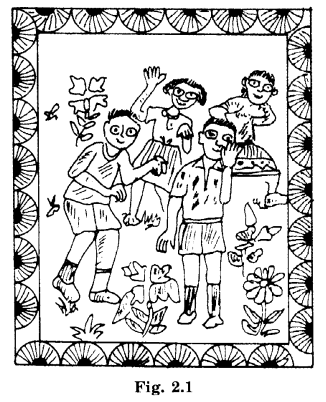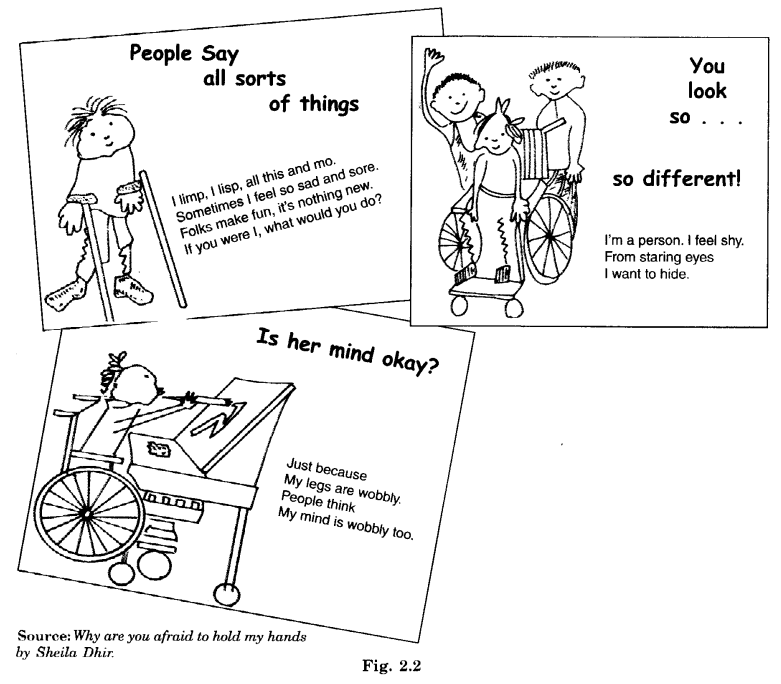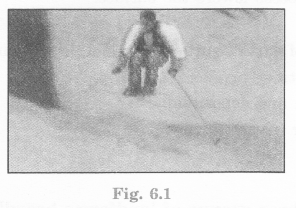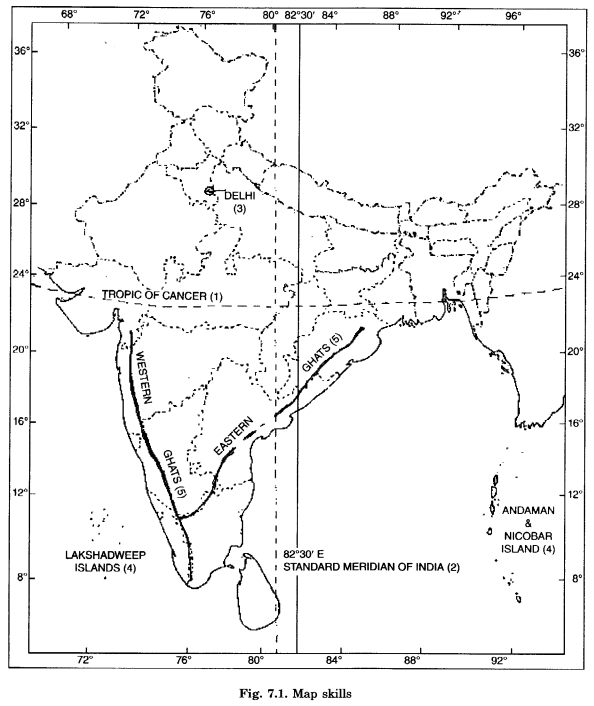NCERT Solutions for Class 6 Social Science Civics Chapter 2 Diversity and Discrimination are part of NCERT Solutions for Class 6 Social Science. Here we have given NCERT Solutions for Class 6 Social Science Civics Chapter 2 Diversity and Discrimination.
| Board | CBSE |
| Textbook | NCERT |
| Class | Class 6 |
| Subject | Social Science Civics |
| Chapter | Chapter 2 |
| Chapter Name | Diversity and Discrimination |
| Number of Questions Solved | 15 |
| Category | NCERT Solutions |
NCERT Solutions for Class 6 Social Science Civics Chapter 2 Diversity and Discrimination
NCERT TEXTBOOK QUESTIONS (Pages 22-23)
Question 1.
Match the following statements in a way that challenges stereotypes:
| a. Two surgeons were sitting down to lunch when one of them made a call on the mobile phone | 1. suffers from chronic asthma |
| b. The boy who won the drawing competition went to the dias | 2. to become an astronaut which she did. |
| c. One of the fastest athletes in the world | 3. to speak with her daughter who had just returned from school. |
| d. She was not that well-off but had a dream | 4. on a wheelchair to collect his prize. |
Answer:
a → 3
b → 4
c → 1
d → 2
Question 2.
How can the stereotype that girls are a burden on their parents affect the life of a daughter? Imagine this situation and list at least five different effects that this stereotype can have on the way daughters get treated in the house.
Answer:
When the stereotype people think that daughter is a burden on the parents, it affects the life of the girl child in the following ways:
- She feels guilty that she is a burden on the family.
- The daughters are not sent to school.
- They are not given nutritional food from the parents. Milk, butter, fruits are kept for the boys.
- They are deprived of love, care, and attention.
- When daughters fall sick-they do not get proper medical care and attention.
Question 3.
What does the Constitution say with regard to equality? Why do you think it is important for all people to be equal?
Answer:
With regards ta. equality the Constitution says:
- Everyone has equal rights and opportunities.
- Untouchability is seen as a crime and legally abolished by law.
- People are free to choose the kind of work they wish to do.
- Government jobs are open to all people.
The equality of all persons is seen as a key that unites us all as Indians. The Constitution also placed responsibility on the government to take specific steps to realize that this right to equality to poor and other deprived communities.
Question 4.
Sometimes people make prejudiced comments in our presence. We are often not in a position to do anything about this because it is difficult to say something right then and there. Divide the class into groups and each group discuss what they could do in one of the following situations:
- A friend begins to tease a classmate because he is poor.
- You are watching TV with your family and one of them makes a prejudicial comment about a particular religious community.
- Children in your class refuse to share their food with a particular person because they think she is dirty.
- Someone tells you a joke that makes fun of a community because of their accent.
- Some boys make remarks about girls not being able to play games as well as them.
Discuss in class what the different groups have suggested for the above situations, and also talk about the problems that can come up when raising the issue.
Answer:
- I would try to convince my friend that being poor is not a crime nor a matter of laughter. Hence, he should not tease his classmate. Instead, he should take care of his dignity and self-respect.
- I would stop him/her to do that.
- I would advise my classmates to be friendly with one and all.
- I would not get involved in the joke and would proceed from their immediately
- I would try to convince those boys that girls are in no way less efficient than their male counterparts. I would give examples of Kalpana Chawla and Sunita Williams who did what many men could not think of.
INTEXT QUESTIONS
Question 1.
Question Box: (NCERT Page 14)
Below are some statements on people living in rural and urban areas. Tick mark those that you agree with:
On Rural People
- More than 50% of all Indians live in villages.
- Villagers do not care about their health. They are full of superstition.
- People in the villages are backward and lazy. They do not like to work.
- In peak harvesting and plantation season, families spend 12 to 14 hours working in the fields.
- Villagers are dirty and not hygienic.
On Urban People:
- Life in the city is easy. People here are spoilt and lazy.
- In cities, families spend very little time with each other.
- People in towns only care about money, not about people.
- Living in a city is expensive. A large part of people’s earnings is spent on rent and transport.
- City people cannot be trusted, they are cunning and corrupt.
Answer:
On Rural People
- ✓
- ✓
- ✗
- ✓
- ✗
On Urban People
- ✗
- ✓
- ✓
- ✓
- ✗
Question 2.
What are prejudices? What does prejudice mean?
Answer:
Prejudices are our opinions which we make about certain people. Some examples are.
- Village people are dirty, lazy, and ignorant.
- City people are cunning and corrupt.
By prejudice we mean, “to judge others negatively and with inferiority.”
Question 3.
Look again at the statements that you believed to be true about rural and urban life in India. Do you have a prejudice against rural or urban people? Find out if this is shared by others and discuss the reasons why people have these prejudices.
Can you list some of the prejudices that you have noticed around you? How do they affect the ways in which people treat each other? (NCERT Page 14)
Answer:
- No, we do not have a prejudice against the rural or urban people.
- This view is also shared by others around us.
- Some people have prejudices against others because of the following reasons.
- Negative attitude towards others.
- Superiority complex.
- Treating oneself above all others.
- Overconfidence in oneself.
- Wrong attitude formation.
- Pessimism,
- Prejudices noticed around us:
- Caste
- Colour
- Eating habits.
- They affect the ways in which people treat each other.
- They laugh at
- They tease
- They speak the fifty languages
- Sometimes they begin to abuse others.
Question 4.
Arrange the statements given below in these two sections, according to what you think is appropriate for the section.

- They are well behaved.
- They are soft-spoken and gentle.
- They are physically strong.
- They are naughty.
- They are good at dance and painting.
- They don’t cry
- They are rowdy
- They are good at sport
- They are good at cooking
- They are emotional
Answer:
Girls
1, 2, 5, 9, 10
Boys
3, 4, 6, 7, 8
Question 5.
Now check, with your teacher’s help, who has put which statement where. Find out and discuss people’s reasons for doing this. Are the qualities you put in for boys something that boys are born with? (NCERT Page 15)
Answer:
Girls
- They are well behaved.
- They are soft-spoken and gentle.
- They are good at dance and painting.
- They are good at cooking.
- They are emotional.
Boys
- They are physically strong.
- They are naughty.
- They do not cry.
- They are rowdy.
- They are good at sport.
Yes, the qualities of boys which we have put in for boys are something that boys are born with.
Question 6.
Question Box: (NCERT Page 16)
The children you see in the illustrations here were seen as ‘disabled’. This term has been changed and now the term used is ‘children with special needs. Common stereotypes about them are given in large letters. Their own feelings and thoughts to are given.

- Discuss what these children are saying about stereotypes regarding them and why.
- Do you think children with special needs should be a part of regular schools or study in a separate school? Give reasons for your answer.
Answer:
- Picture I:
Stereotypes. People say all sorts of things
The child says:- I limp.
- I lisp, all this and more.
- Sometimes I feel so sad and sore.
- If you were I, what would you do?
- Picture II:
Stereotypes. You look so so different!
The child says:- I am a person.
- I feel shy.
- From staring eyes, I want to hide.
- Picture III:
Stereotypes. Is her mind okay?
The child says:- Just because my legs are wobbly.
- People think my mind is wobbly too.
- These children are saying about stereotypes because they understand the attitudes of the people around them. They mock them and they tease them.
- We think children with special needs should be a part of regular school and should not study in a separate school because they would learn many things more in regular school and will not feel degraded.
Question 7.
Question Box: (NCERT Page 17)
You can take other statements such as They are soft and gentle or They are well behaved and discuss how these are applied to girls. Do girls possess these qualities at birth or do they learn such behaviour from others? What do you think about girls who are not soft and gentle and those who are naughty?
Answer:
These characteristics are applied to girls because they are born soft, gentle. They are well behaved.
- The girls possess these qualities at birth most of them. They also leam such behavior afterward, remaining in the house or school.
- The girls who are not soft and gentle and who are naughty, acquire these qualities from society.
Question 8.
Question Box: (NCERT Page 18)
A common stereotype about Muslims is that they are not interested in educating girls and therefore do not send girls to school. However, studies have now shown that poverty amongst Muslims is an important reason why Muslim girls do not attend school or leave school after a few years.
Wherever effort has been made to reach education to the poor, there the Muslim community has shown an interest in sending their girls to school. For example in the state of Kerala, the distance between the school and the home is not much. There is a good government bus service that helps teachers reach schools in rural areas and over sixty percent of the teachers are women. These factors have helped children from poorer families, including Muslim girls, attend school in much larger numbers.
In other states, where such efforts have not been made children from poorer families whether Muslim, tribal, or so-called lower castes find it difficult to attend school. Therefore, poverty not religion is the cause for the non-attendance of Muslim girls in school.
Study the above extract and answer the questions given below:
- What is a common stereotype about Muslims?
- What reason has been given in recent studies for not sending Muslim girls to schools?
- Why do Muslim girls study in schools in Kerala along with other girls?
- What is the real cause of Muslim girls not going to school?
Answer:
- The common stereotype about Muslims is that Muslims are not interested in educating their girls and that they do not send their girls to schools.
- The studies have suggested poverty as the reason for not sending Muslim girls to school.
- In Kerala Muslim girls go to schools along with other girls in large numbers:
- The distance between the school and home is very less.
- Women teachers are in large numbers in schools.
- The bus service in Kerala is very efficient.
- It is poverty, not religion.
Question 9.
Question Box: (NCERT Page 19)
What is the difference between discrimination and stereotype?
Answer:
Difference:
| Discrimination | Stereotype |
| 1. Discrimination is the state in which one person is discriminated from others due to his poor and bad economic condition. | 1. Fixing people into one image is called a stereotype. |
| 2. Untouchables, Dalits etc. | 2.Stingy, lazy, criminal etc. |
How do you think a person who is discriminated against might feel?
Answer:
He might feel hurt and might revolt against society.
Question 10.
Question Box: (NCERT Page 21)
Despite the children offering money, the cartmen refused them. Why?
How did people at the station discriminate against Dr. Ambedkar and his brothers?
How do you think Dr. Ambedkar felt as a child when he saw the stationmaster’s reaction to his statement that they were Mahars?
Have you ever experienced prejudice or witnessed an incident of discrimination? How did this make you feel?
Read the story of Bhimrao Ambedkar and answer the following questions:
- Despite the children offering money, the cartmen refused them. Why?
- How did people at the station discriminate against Dr. Ambedkar and his brothers?
- How do you think Dr. Ambedkar felt as a child when he saw the stationmaster’s reaction to his statement that they were Mahars?
- Have you ever experienced prejudice or witnessed an incident of discrimination?
- How did this make you feel?
Answer:
- Despite the children offering money, the cartman refused them because they were Mahars, the untouchable caste of the Bombay Presidency.
- People at the station discriminated against Dr. Ambedkar and his brothers by refusing them to sit or studying near the upper caste people.
- Dr. Ambedkar felt very disgusted when he saw the station master’s reaction to his statement that they were Mahars.
- Yes, we have seen prejudice in our childhood.
- This made us feel disappointed and sad.
Question 11.
Question Box:
Discuss:
- In addition to the lower castes being discriminated against, there are also various other communities that are subject to discrimination.
- Can you think of a few other examples of discrimination?
- Discuss the ways in which persons with special needs might be subject to discrimination. (NCERT Page 21)
Answer:
- Muslims, Christians, tribals, handicapped, disabled persons, etc.
- Yes.
- Special training to teachers.
We hope the NCERT Solutions for Class 6 Social Science Civics Chapter 2 Diversity and Discrimination help you. If you have any query regarding NCERT Solutions for Class 6 Social Science Civics Chapter 2 Diversity and Discrimination, drop a comment below and we will get back to you at the earliest.



